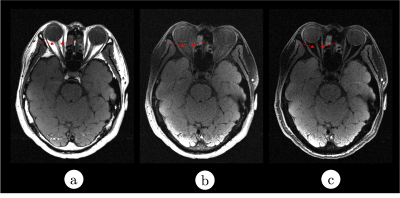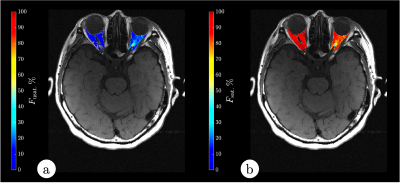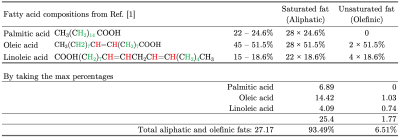3857
Orbit Fat Quant with PASTA and Unsaturated- and Saturated-Fat Opposed Phase.
Vadim Malis1, Asako Yamamoto1, Yoshimori Kassai2, Won Bae1, Marianne McDonald3, and Mitsue Miyazaki1
1Radiology, UC San Diego, San Diego, CA, United States, 2Canon Medical, Tochigi, Japan, 3UC San Diego, San Diego, CA, United States
1Radiology, UC San Diego, San Diego, CA, United States, 2Canon Medical, Tochigi, Japan, 3UC San Diego, San Diego, CA, United States
Synopsis
In general, orbit fat suppression is not achieved due to the presence of unsaturated fat signals near water resonance. We have developed PASTA with unsaturated and saturated fat opposed phase (USOP) like a Dixon method. Semi-quantitative analysis shows about 6 – 18% of unsaturated fat in the orbits. Interestingly, two subjects having lazy eye (amblyopia) with double visions (diplopia) shows decreased in unsaturated fat signal.
Introduction
In MRI, basic fat signal like subcutaneous adipose resonates at -3.5 ppm from the water peak. Thus, chemical shift selective fat suppression like CHESS, SPIR, and SPAIR works in general adipose tissue-like saturated fatty acid. However, orbits have quite different compositions of fats consisting of both saturated (-3.5 ppm) and unsaturated fatty acid (~ +0.5 ppm from the water peak as F0). Therefore, chemical shift selective CHESS, SPIR, and SPAIR does not suppress orbit fat completely. The aim of this study is to develop an orbit fat suppression technique and semi-quantify the relative ratio of unsaturated and saturated fat in orbits.Methods
Orbit fat compositions are palmitic acid (22 – 24.6%), oleic acid (45 – 51.5%), and linoleic acid (15 – 18.6%) [1]. The palmitic is basically saturated fatty acid which resonates at -3.5 ppm from the water peak. Oleic acid has monosaturated protons and linoleic acid has di-unsaturated protons (2 double bonds). Although oleic acid with a single double-bond is abundant in orbits, a long carbon chain of saturated fat or many saturated fat protons are present in orbits. We propose an orbit fat suppression using polarity-altered spectral and spatial selective acquisition (PASTA) FSE with unsaturated and saturated fat opposed (USOP) like a Dixon type acquisition. To semi-quantify the relative ratio of unsaturated fat and saturated fat, we acquired three different sequences: 1) In-phase: contains both saturated and unsaturated fat; 2) PASTA only: depicts water and unsaturated fat; and 3) PASTA with USOP: gives water only images. All three series shared the following parameters: TE/TR = 15/800 ms, NEX = 1, FA = 90°, axial orientation FOV = 22×22 cm, matrix size 320×320. Three healthy subjects (47 ± 21 y.o.) and 2 subjects (67 ± 8 y.o.) having lazy eye (amblyopia) with double visions (diplopia) were recruited with an IRB approval and scanned on a clinical 3T (Vantage Galan, version 6, Canon Medical, Japan) scanner with a 32-channel brain coil.Results
PASTA with USOP gives orbits with fat suppressed images, as shown in Figure 1. PASTA only with water excitation gives incomplete fat suppression. PASTA with USOP gives excellent fat suppressed orbit images. The unsaturated fat in percentage, over both saturated and unsaturated fat as 100%, was between 6 and 18 %, which was similar to the unsaturated and saturated compositions in Table 1 from Ref. [1]. Other protons in fatty acids were neglected, due to their chemical shift differences. Interestingly, the two subjects on one side of eye with amblyopia and diplopia have had less unsaturated fat as compared with their normal side. Figure 2 shows colormaps with the results of fat quantification in the subject with amblyopia and diplopia. The lazy eye subject in Figure 2 has had normal and lazy eye with 18% and 8% unsaturated fat percentage, respectively. The other subject with the lazy eye has the normal and lazy eye of unsaturated fat in 11% and 5%, respectively. Other healthy subjects without amblyopia and diplopia gave similar unsaturated fat compositions in their right and left eyes within a 1 – 2% difference, Table 2.Discussion
PASTA-FSE with USOP allows fast acquisition of orbits and shows excellent orbit fat suppression. The semi-quantification of orbit fat presents about 6 to 18% of unsaturated fat presence depending on subjects. Orbit fat plays an important role in ocular physiology and oculomotricity. Our experimental result indicates lower unsaturated fat composition or unbalanced unsaturated fat composition between the two orbits may have affected oculomotricity in amblyopia and diplopia. The reason of having saturated fat signal remind after the water excitation by PASTA is unknown. However, small residual saturated fat after PASTA FSE can be evolved with uncoupled signals of a J-coupling effect in multiple refocusing pulses in FSE. This residual saturated fat signals could be canceled out by near water unsaturated fat (+0.5 ppm) and saturated fat (-3.5 ppm) opposed like the Dixon technique.Conclusions
Orbit fat suppression in FSE was developed. Orbit fat quant of unsaturated and saturated fat becomes possible. Further clinical studies are required.Acknowledgements
No acknowledgement found.References
[1] Sires BS, et al. Ophthalmic Plastic & Reconstructive Surgery. 1998; 14(6):403-414.
[2] Miyazaki M, et al. ISMRM. 1995; p657.
Figures

Figure 1: On the left (a) In-Phase (both water and fat), middle (b) PASTA (water and unsaturated fat), right (c) PASTA with USOP (only water) axial images for the same slice in a healthy volunteer. Orbit fat is bright in the In-Phase, somewhat suppressed in PASTA, and completely suppressed in PASTA with USOP. Regions are marked with red arrows.

Figure 2: Colormaps of fractions of unsaturated (a) and saturated (b) fat for a subject with amblyopia on the left eye. The unsaturated fat percentage of the right and left was 18% and 8% respectively.

Table 1: Fatty acid composition from Ref. [1].

Table 2: Average unsaturated fat fractions measured in the regions of interest placed inside the left and right rectus muscles for healthy and amblyopia/diplopia volunteers.